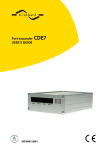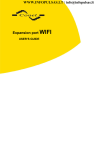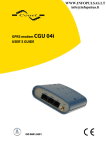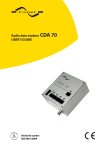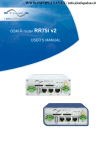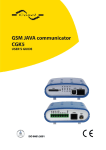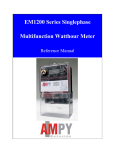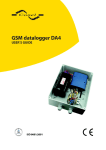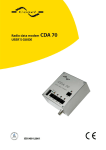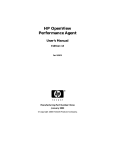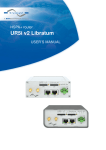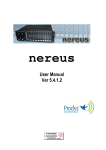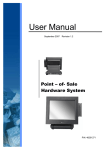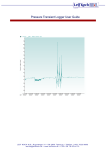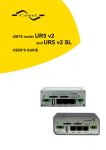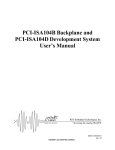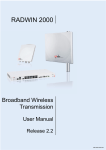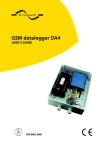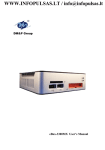Download User manual - Infopulsas
Transcript
WWW.INFOPULSAS.LT [email protected] Radio data modem USER´S GUIDE CDX 800 OBSAH Contents 1.SAFETY INSTRUCTIONS.......................................................................................................4 2.DESCRIPTION OF THE CDX 800 COMMUNICATION MODULE..........................................5 2.1.General description...............................................................................................................5 2.2.Examples of possible applications........................................................................................5 2.3.Compatibility with other Conel company modems................................................................5 2.4.Description of the individual parts of the CDX 800................................................................6 2.4.1.Radio module ................................................................................................................6 2.4.2.Control microprocessor...................................................................................................6 2.4.3.Inputs and outputs for telemetry.....................................................................................6 2.4.4.PORT1 interface.............................................................................................................7 2.4.5.Optional hardware interface PORT2...............................................................................7 2.4.6.User interface protocols..................................................................................................7 2.4.7.Technical parameters ....................................................................................................8 2.5.Module state indication..........................................................................................................9 2.6.User interfaces (connectors).................................................................................................9 2.6.1.PORT1 and PORT2 connectors - RS232.....................................................................11 2.6.2.Connection of PORT1 connector (RS485)...................................................................12 2.6.3.Connection of PORT2 connectors (RS485)..................................................................13 Connection of PORT2 connectors (RS422)...........................................................................15 2.6.4.Connection of PORT2 connectors (M-BUS).................................................................17 2.6.5.Connection of PORT2 connectors (CNT).....................................................................19 2.6.6.Connection of I/O connector.........................................................................................20 2.6.7.Power supply connector - PWR....................................................................................21 2.7.Antenna connection.............................................................................................................23 2.8.Power supply.......................................................................................................................23 2.9.Ports technical specifications..............................................................................................24 2.10.CDX 800 configuration......................................................................................................27 2.11.Service cable.....................................................................................................................27 2.12.Accessories.......................................................................................................................28 2.13.Additional accessories.......................................................................................................28 2.14.Assembly procedure..........................................................................................................30 2.15.Mechanical and inbuilt dimensions and recommendation for mounting............................32 2.16.Product marking................................................................................................................35 2.17.PORT2 marking.................................................................................................................35 2.18.CDX 800 production labels................................................................................................35 2.19.Production labels of interfaces PORT2.............................................................................35 3.CIO - ANALOGUE INPUTS AND BINARY OUTPUTS.........................................................36 3.1.Introduction..........................................................................................................................36 3.2.Description of I/O signal evaluation and reception..............................................................36 3.2.1.Analogue input..............................................................................................................36 3.2.2.Binary output.................................................................................................................36 3.2.3.I/O signals inside CDX 800...........................................................................................36 3.2.4.I/O signal parameters...................................................................................................37 3.3.Measuring other CDX 800 signals.......................................................................................37 3.3.1.Measuring the supply voltage.......................................................................................37 3.3.2.Measuring internal CDX 800 temperature....................................................................37 3.3.3.Measuring DSR output signal level...............................................................................37 2 OBSAH 3.4.Output signal for disconnection of supply voltage...............................................................38 3.5.Technical parameters..........................................................................................................38 3.6.Connecting CIO signals to user device...............................................................................38 4.REFERENCE.........................................................................................................................40 5.LINKS TO RELATED PRODUCTS OF THE MANUFACTURER..........................................40 5.1.Systems...............................................................................................................................40 5.2.Protocols.............................................................................................................................40 5.3.Program...............................................................................................................................40 6.PRODUCT DISPOSAL INFORMATIONS.............................................................................40 7.COMPLAINTS PROCEDURE................................................................................................41 8.WARRANTY..........................................................................................................................43 Symbols used Danger – important notice, which may have an influence on the user’s safety or the function of the device. Attention – notice on possible problems, which can arise to in specific cases. Information, notice – information, which contains useful advices or special interest. Conel s.r.o., Sokolska 71, 562 04 Usti nad Orlici, Czech Republic Issue in CZ, 25/06/09 3 SAFETY INSTRUSTIONS 1. Safety instructions Please observe the following safety instructions: • The communication module must be used in compliance with any and all applicable international and national laws and in compliance with any special restrictions regulating the utilization of the communication module in prescribed applications and environments. • Use only the original Conel company accessories. Thus you will prevent possible health risks and damage to the devices and ensure compliance with all relevant provisions. Unauthorised modifications or utilization of accessories that have not been approved may result in damage to the communication module and in a breach of applicable regulations. Unauthorized modifications or utilization of accessories that have not been approved may result in the termination of the validity of the guarantee, which, however, does not affect your legal rights. • The communication module must not be opened. • Voltage at the feed connector of the communication module must not be exceeded. • Do not expose the communication module to extreme ambient conditions. Protect the communication module against dust, moisture and high temperature. • It is recommended that the communication module should not be used at petrol stations. We remind the users of the duty to observe the restrictions concerning the utilization of radio devices at petrol stations, in chemical plants, or in the course of blasting works in which explosives are used. • When using the communication module in close proximity of personal medical devices, such as cardiac pacemakers or hearing aids, you must proceed with heightened caution. • If it is in the proximity of TV sets, radio receivers and personal computers, the telephone may cause interference. • Caution! Don’t connect power supply to data connectors, it could be damage data connectors or modem. • Caution! Don’t connect data cable with service interconnection SEPRO to M-BUS interface, it could be damage SEPRO. • It is recommended that you should create an appropriate copy or backup of all the important settings that are stored in the memory of the device, to database by help program Radwin, reference [3]. 4 CDX 800 DESCRIPTION 2. Description of the CDX 800 communication module 2.1. General description The communication module is a device for wireless data transmission. The communication module is one of the basic elements of AGNES system. The system AGNES characteristics are described in reference [1]. The 869 MHz according to CEPT/ERC Rec 70-03 for used radio frequency and for running equipment of a short distance (telemetrics, security systems, fleet management) or for radio equipment of small performance bands are used for the wireless communication as a line layer. ARNEP protocol is implemented above the line layer. The protocol ARNEP is described in reference [2]. One may simply imagine the CDX 800 module as a protocol converter between the user device (PLC automatic, PC, data terminal, etc.) and radio network; it provides the user with possibility to communicate simply between all the systems. The CDX 800 module is controlled by communication 32-bit microprocessor. It ensures radio communication, data transfer on serial user interfaces (1 x RS232/RS485, 1 x optional port a 1 x CIO) and a number of diagnostic and service features. CDX 800 module in the basic version has one user interfaces RS232/RS485 (multi-communication ports), which is program configurable, and one interface for direct connection of inputs and outputs (CIO) for data collection and technological process management. It is possible to set transfer parameters and communication protocol for each user interface separately. As a result you may communicate with various user interfaces using different communication protocols on serial interface. Port 2 is configurable. RS232, RS485/RS422, M-BUS or CNT interfaces can be ordered as its interface position. Separate the two CDX 800 modems by a minimum distance 10 meters because of communication problems. 2.2. Examples of possible applications • Security systems • Telematics • Telemetrics • Remote monitoring • Automatic sensors • Metering 2.3. Compatibility with other Conel company modems Regarding the communication and data transfers, the CDX 800 module is compatible with modules communicating via the ARNEP protocol on the RS232 interface. This means it is possible to combine different types in one network and simply extend for example an existing network of the CGU 04i CDA70 modules with new communication points using CDX 800 modules. In addition, the CDX 800 module provides some features not included in older types. User and industrial communication protocol implemented on serial interfaces are compatible with the protocols used for Conel radio modems (e.g. CDA 70). Thus you may establish complex combined data networks consisting of both radio and GPRS modems. 5 CDX 800 DESCRIPTION 2.4. Description of the individual parts of the CDX 800 2.4.1. Radio module The radio transceiver XBee has been used for wireless communication on the radio channel. The module achieves high-rate parameters thanks to used digitalization of both the transmitter and receiver. The modem works in the band 869 MHz. For usage within specific regions, restrictions as to the frequency selection are provided to comply with the appropriate legislation. The transmitter works with the OFDM modulation; the transmitting power output can be programmed in steps of 1 mW up to 315 mW. The maximum transmission rate is 24 kb/s with duty cycle receiving/transmitting 10:1. The duty cycle is according to the ERC/REC 70-03 document. 2.4.2. Control microprocessor Thirty-two-bit microprocessor Freescale Coldfire with 512 kByte FLASH EEPROM memory and real-time circuit with reserve power supply makes for the basis of CDX 800 control microprocessor. Software is based on real-time operating system that processes simultaneous tasks. Thus parallel operation of all external interfaces of the communication module is maintained. The microprocessor is connected through the synchronous serial interface to the radio component and controls the communication via the radio channel. Towards a user it connected on serial interfaces, typically RS232, and direct I/O signal processing circuits. The microprocessor enables connection of up to two user devices through two serial interfaces. The ports are linked to RJ45 connectors marked PORT1, PORT2. All user interface signals are protected against over voltage on the data cable. Device with different communication protocol can be connected to each interface. The microprocessor may work as a protocol converter between separate serial user interfaces. The wide scale of CDX 800 module features can be configured through any RS232 serial user interface using service software. In case other than RS232 interface device needs to be connected, e.g. RS485/422, it is possible to connect level converter to the serial port according to particular application. The microprocessor can control such external converter. The microprocessor further manages numerous functions of servicing, diagnostic and installation purposes. The computer saves various information such as GPRS data communication statistics, ports activity, power failure, voltage of backup power source and temperature inside the CDX 800 module to its memory. Configuration of the CDX 800 module is stored in the FLASH EEPROM memory. The RADWIN service software has been designed for setting of the CDX 800 modem configuration. The description of program RADWIN is in reference [3]. 2.4.3. Inputs and outputs for telemetry Apart from serial data interfaces there is CIO interface established in the module. These are 5 signals to be used as analogue or binary inputs or binary outputs with an open collector. The input can be analogue 0 - 5 V or digital with control level adjustment. The output is an open collector able to switch up to 500 mA. Reading and control of I/O signals is possible from the remote CDX 800 module or any serial user interface. Two CDX 800 modules can 6 CDX 800 DESCRIPTION make up simple technology control, where changes on input signals of one module can control remote outputs of the other module and vice versa. Interface between I/O connector and technology is supplied for general use, providing voltage and current inputs of adjustable ranges, inputs for resistance measuring (thermometers and the like), optically separated binary inputs and relay outputs. With the equipment you may establish simple telemetry at low cost, without the use of industrial control automatic. Inputs and outputs for telemetry. 2.4.4. PORT1 interface PORT1 interface in the CDX 800 modem is software configurable between serial link RS232 and RS485 bus. Configuration is possible by the program RADWIN [3]. If it is selected RS485 bus, the CDX 800 modem can automatically detects service cable. After time of modem configuration the PORT1 interface is temporary switched to RS232 serial link. 2.4.5. Optional hardware interface PORT2 PORT2 on the CDX 800 back panel provides for direct use of other HW interface than the standard RS232. It is due to the design of the interface as a separate module built inside CDX 800. Thus you may use the CDX 800 module combined with RS232, RS485/RS422, M-BUS or CNT. Such interface is physically linked to RJ45 PORT2 connector. 2.4.6. User interface protocols There are numerous standard industrial protocols implemented on the user interface: ARNEP UI AT modem DLMS MODBUS IWKA M-BUS MODBUS PROFIBUS RADOM RDS CONEL SAUTER SBUS Transparent bus New protocols can be implemented according to the customer's needs not supported by the communication module yet. The CDX 800 module also enables the implementation of customized user protocol directly by the customer. 7 CDX 800 DESCRIPTION 2.4.7. Technical parameters Radio Complying with the Power safety following standards: EMC Radio parameters Frequency bands Transmission power Sensitivity Communication speed Temperature range Function Storage Supply voltage (car dashboard) Consumption TX RX Dimensions Weight Antenna connector User interfaces PORT1 PORT2 CIO 8 EN 60 950-1 ed. 2 ETSI EN 301 489-1:V1.8.1 ETSI EN 300 220-1 V2.1.1 869 MHz based on CEPT/ERC Rec 70-03 1 - 315 mW -112 dBm 24 kbps (10% TX/RX) -20 oC to +55 oC -40 oC to +85 oC +10 to +30 V DC 3W 350 mW 30 x 90 x 102 mm (moulding fixed to 35 mm DIN rail) 150 g RPSMA – 50 Ohm RS232/RS485 – RJ45 connector (150 b/s – 115,200 b/s) SW configuration Optional - RJ45 connector (150 b/s - 115,200 b/s) RS232, RS485, M-BUS or I/O 5 SW adjustable inputs (analogue, binary) / outputs (open collector) - RJ45 connector CDX 800 DESCRIPTION 2.5. Module state indication There are two LED indicators on the front panel informing on its status. Colour Description Definition Flashes once a sec…….proper function On…………………..……fault Off…………………….….no DC supply GREEN PWR RED TX Off …......………............no activity On …......…………........transmitting on the RF channel GREEN R Off …......…….…......... no activity On ....….........................receiving on the local modem on the RF YELLOW C Off …......…….…......... no activity On ..….......................... receiving on the RF RED TX1 Off …......…….…......... no activity On ..…...........................transmitting on the port 1 GREEN RX1 Off …......…….…......... no activity On ..…...........................receiving on the port 1 RED TX2 Off …......…….…......... no activity On ..…...........................transmitting on the port 2 GREEN RX2 Off …......…….…......... no activity On ..…...........................receiving on the port 2 2.6. User interfaces (connectors) There are a two RJ45 (PORT1 and PORT2), a RJ12 (PWR) and a RPSMA (ANT) connectors located on the back panel. Two connectors marked PORT1 and PORT2 are used for serial user interfaces (typically RS232). The fourth connector marked PWR is used for connecting the supply adapter. Antenna is connected to the last ANT connector. Port RS232/RS485 Optional interface 9 Power supply CDX 800 DESCRIPTION An RJ45 (CIO) connector is located on the front panel of CDX 800. CIO connector is for direct input and output connections for data collection and technology control. Modem state 10 Port CIO CDX 800 DESCRIPTION 2.6.1. PORT1 and PORT2 connectors - RS232 The RJ45 panel socket (RS232 – DCE – Data Communication Equipment). Pin Signal Data flow Description No. name direction 1 RTS Request To Send Input 2 CTS Clear To Send Output 3 DTR Data Terminal Ready Input 4 DSR Data Set Ready - connected to +4 V through 330 Output Ohm 5 GND GROUND – signal ground 6 RXD Receive Data Output 7 CD Carrier Detect Output 8 TXD Transmit Data Input 43B43B43B43B Circuit example of the meter with modem CDX 800: Meter Pin 1 – RTS Pin 2 – CTS Pin 3 – DTR Pin 4 – DSR Pin 5 – GND Pin 6 – RXD Pin 7 – CD Pin 8 – TXD GND RXD TXD Modem CDX 800 Circuit example of the PC with modem CDX 800: PORT1 Cable KD-2 PORT2 PWR • 11 the KD2 cable is connected to serial PC port (example COM1) Modem CDX 800 CDX 800 DESCRIPTION Circuit example of the RS232 equipment with modem CDX 800: PORT1 Cable KD-2 PORT2 Modem CDX 800 PWR 2.6.2. Pin No. 1 2 3 4 5 6 7 8 Connection of PORT1 connector (RS485) Panel socket RJ45. Signal mark --------TxRxRS485 B (-) --------TxRx+ RS485 A (+) --------- Description Data flow direction Input/Output Input/Output Circuit example of the meter with modem CDX 800 with data length less then 10 m: Meter Meter 12 SGND RS485 (-) RS485 (+) SGND RS485 (-) RS485 (+) Pin 1 – --Pin 2 – --Pin 3 – RS485 (-) Pin 4 – --Pin 5 – --Pin 6 – RS485 (+) Pin 7 – --Pin 8 – --- Modem CDX 800 CDX 800 DESCRIPTION Circuit example of the meter with modem CDX 800 with data length more then 10 m: Meter SGND RS485 (-) RS485 (+) 1X 2X 1Y 2Y OVPM-21 Meter Pin 1 – --Pin 2 – --Pin 3 – RS485 (-) Pin 4 – --Pin 5 – --Pin 6 – RS485 (+) Pin 7 – --Pin 8 – --- Modem CDX 800 SGND RS485 (-) RS485 (+) At RS485 data cable more then 10m it is need to use over-voltage protection on CDX 800 modem side! 2.6.3. Connection of PORT2 connectors (RS485) Panel socket RJ45. Pin Signal Description No. mark 1 GND Signal and supply ground 2 GND Signal and supply ground 3 TxRxRS485 B (-) 4 TxRx+ RS485 A (+) 5 TxRxRS485 B (-) 6 TxRx+ RS485 A (+) 7 +12V EXT External power supply +10,8 ÷ +15,6V 8 +12V EXT External power supply +10,8 ÷ +15,6V ATTENTION! External supply is for converter RS485! Data flow direction Input/Output Input/Output Input/Output Input/Output The converter must have external power supply because of galvanic separated. 13 CDX 800 DESCRIPTION Circuit example of the meter with modem CDX 800 with data length less then 10 m: Meter Meter Pin 1 – SGDN Pin 2 – SGND Pin 3 – RS485 (-) Pin 4 – RS485 (+) Pin 5 – RS485 (-) Pin 6 – RS485 (+) Pin 7 – +12V EXT Pin 8 – +12V EXT SGND RS485 (-) RS485 (+) SGND RS485 (-) RS485 (+) DC Modem CDX 800 + Circuit example of the meter with modem CDX 800 with data length more then 10 m: Meter SGND RS485 (-) RS485 (+) 1X 2X Pin 1 – SGND Pin 2 – SGND Pin 3 – RS485 (-) Pin 4 – RS485 (+) Pin 5 – RS485 (-) Pin 6 – RS485 (+) Pin 7 – +12V EXT Pin 8 – +12V EXT 1Y 2Y OVPM-21 Meter SGND RS485 (-) RS485 (+) DC Modem CDX 800 + At RS485 data cable more then 10m it is need to use overvoltage protection on CDX 800 modem side! 14 CDX 800 DESCRIPTION Connection of PORT2 connectors (RS422) Panel socket RJ45. Pin Signal Description No. mark 1 GND Signal and supply ground 2 GND Signal and supply ground 3 RxDReceive Data (-) 4 RxD+ Receive Data (+) 5 TxDTransmit Data (-) 6 TxD+ Transmit Data (+) 7 +12V EXT External power supply 8 +12V EXT External power supply ATTENTION! External supply is for converter RS422! Data flow direction Output Output Input Input The converter must have external power supply because of galvanic separated. Circuit example of the meter with modem CDX 800 with data length less then 10 m: Meter Pin 1 – SGDN Pin 2 – SGND Pin 3 – RxD (-) Pin 4 – RxD (+) Pin 5 – TxD (-) Pin 6 – TxD (+) Pin 7 – +12V EXT Pin 8 – +12V EXT SGND TxD (-) TxD (+) RxD (-) RxD (+) DC 15 + Modem CDX 800 CDX 800 DESCRIPTION Circuit example of the meter with modem CDX 800 with data length more then 10 m: Meter SGND TxD (-) TxD (+) RxD (-) RxD (+) 1X 2X 1Y 2Y 1X 2X 1Y 2Y Pin 1 – SGND Pin 2 – SGND Pin 3 – RxD (-) Pin 4 – RxD (+) Pin 5 – TxD (-) Pin 6 – TxD (+) Pin 7 – +12V EXT Pin 8 – +12V EXT OVPM-31 DC Modem CDX 800 + At RS485 data cable more then 10m it is need to use over-voltage protection on CDX 800 modem side! 16 CDX 800 DESCRIPTION 2.6.4. Connection of PORT2 connectors (M-BUS) Panel socket RJ45. Pin Signal Description No. mark 1 SGND Signal and supply ground 2 SGND Signal and supply ground 3 TxRxM-BUS B (-) 4 TxRx+ M-BUS A (+) 5 TxRxM-BUS B (-) 6 TxRx+ M-BUS A (+) 7 +12V EXT External power supply +10,8 ÷ +15,6V 8 +12V EXT External power supply +10,8 ÷ +15,6V ATTENTION! External supply is for converter M-BUS! Data flow direction Input/Output Input/Output Input/Output Input/Output The converter must have external power supply because of galvanic separated. Circuit example of the meter with modem CDX 800 with data length less then 10 m: Meter Meter 17 Pin 1 – SGDN Pin 2 – SGND Pin 3 – M-BUS (-) Pin 4 – M-BUS (+) Pin 5 – M-BUS (-) Pin 6 – M-BUS (+) Pin 7 – +12V EXT Pin 8 – +12V EXT SGND M-BUS (-) M-BUS (+) SGND M-BUS (-) M-BUS (+) DC + Modem CDX 800 CDX 800 DESCRIPTION Circuit example of the meter with modem CDX 800 with data length more then 10 m: Meter SGND M-BUS (-) M-BUS (+) 1X 2X Pin 1 – SGND Pin 2 – SGND Pin 3 – M-BUS (-) Pin 4 – M-BUS (+) Pin 5 – M-BUS (-) Pin 6 – M-BUS (+) Pin 7 – +12V EXT Pin 8 – +12V EXT 1Y 2Y OVPM-21 Meter SGND M-BUS (-) M-BUS (+) DC Modem CDX 800 + M-BUS data cable more then 10m it is need to use over-voltage protection on CDX 800 modem side! 18 CDX 800 DESCRIPTION 2.6.5. Connection of PORT2 connectors (CNT) Panel socket RJ45 Pin Signal number mark 1 BIN0/CNT0 2 BIN1/CNT1 3 BIN2 4 BIN3 5 GND 6 OUT0 7 AN0 8 AN1 Description Binary input/counter input Binary input/counter input Binary input Binary input Signal ground Binary output Analogy input Analogy input Typical connection of CDX 800 measuring circuits: 19 Direction Input Input Input Input Output Input Input CDX 800 DESCRIPTION 2.6.6. Connection of I/O connector Panel socket RJ45. Pin Signal Description No. mark 1 I/O 5 Input/Output - analogue or binary input or binary output (open collector) 2 I/O 4 Input/Output - analogue or binary input or binary output (open collector) 3 I/O 3 Input/Output - analogue or binary input or binary output (open collector) 4 +12V Output + 12V for supply of other circuits (connected directly to modem supply) 5 GND Signal and supply ground 6 I/O 2 Input/Output - analogue or binary input or binary output (open collector) 7 I/O 1 Input/Output - analogue or binary input or binary output (open collector) 8 Service For servicing purposes only Circuit example of the meter with modem CDX 800: Modem CDX 800 20 Data flow direction Input/Output Input/Output Input/Output Output Input/Output Input/Output Input/Output CDX 800 DESCRIPTION 2.6.7. Power supply connector - PWR Panel socket RJ12. Pin Signal Data flow Description No. mark direction 1 +UN Positive pole of supply voltage (10-30 V) 2 PWRSV Open collector output (Power Save) for controlling of Output supply voltage of the whole radio modem, see chapter about CIO 3 INAC Input -power failure supervision. (Analogue input 0-16V) Input 4 +UN Positive pole of supply voltage (10-30 V) 5 GND Negative pole of supply voltage 6 GND Negative pole of supply voltage On the power supply connector it is possible to use the signal INAC (NAP230) for present AC voltage monitoring for power supply (it can be functional only in case of supply accumulator backup). Beware, on INAC (NAP230) input it isn't possible connect link voltage 230 V direct! Circuit example: DC supply Pin 1 – +12V DC Pin 2 – GND Pin 3 – PWRSV + Pin 4 – INAC Modem CDL 800 (CDL 400) DC supply with backup battery with present supply monitoring Pin 1 – +12V Pin 2 – GND Pin 3 – PWRSV Pin 4 – INAC DC + 21 Modem CDL 800 (CDL 400) CDX 800 DESCRIPTION DC supply with backup battery without present supply monitoring Pin 1 – +12V Pin 2 – GND Pin 3 – PWRSV Pin 4 – INAC DC + 22 Modem CDL 800 (CDL 400) CDX 800 DESCRIPTION 2.7. Antenna connection The antenna is connected to CDX 800 by the RPSMA connector on the back panel. RPSMA antenna connector 2.8. Power supply CDX 800 requires DC supply of +10 to +30 V. During reception, consumption is 1 W. During data sending, peak consumption is 3,5 W. For proper function, it is necessary that the power source can supply peak current of 500 mA. 23 CDX 800 DESCRIPTION 2.9. Ports technical specifications • Expansion port RS232 Name of product Power supply Environment Standards RS232 specifications (EN 1434) • .... -20 .. +55 C -20 .. +85 C EN 55022/B ETS 300 342 EN 60950 15 mA 230400 bps ±30 V 20 m M-BUS Voltage Supply power Operating temperature Storage temperature Emission Immunity Safety Max. devices (each 1,5 mA) Max. operating bus current Overload detection Short circuit strength Bus voltage mark Bus voltage space Max. total cable length (300Bd, 200nF/km) 10,8 .. 15,6 V Max. 30 W -20 .. +55 C -20 .. +85 C EN 55022/B ETS 300 342 EN 60950 30 60 mA 100 mA Permanent 36 .. 43 V 24 .. 31 V 1000 m Expansion port M-BUS Name of port Power supply Environment Standards M-Bus specifications (EN 1434) 24 RS232 Internal Operating temperature Storage temperature Emission Immunity Safety Max. operating bus current Max. bit rate Max. overvoltage Max. total cable length (300Bd, 200nF/km) CDX 800 DESCRIPTION • Expansion port RS485/RS422 Name of product Power supply Environment Standards RS485 specifications (EN 1434) External Internal Supply power Supply current Operating temperature Storage temperature Emission Immunity Safety Max. devices (each 1,5 mA) Max. bit rate Overload detection Short circuit strength Max. total cable length (300Bd, 200nF/km) RS485 RS422 10,8 .. 15,6 V .... Max. 30 W Max. 250 mA -20 .. +55 C -20 .. +85 C EN 55022/B ETS 300 342 EN 60950 256 38400 bps 250 mA Permanent 1200 m External or internal power supply of module Expansion port RS485/RS422 it is can evoke by wiring of the jumper J2 and J3 on this module. If it is necessitated external power supply of module, it must be by jumper J2 and J3 connection pin 2 - 3. Internal power supply is evoke of connection pin 1 - 2 on jumper J2 and J3. Interface behaviour of module Expansion port RS485/RS422 it is can evoke by wiring of the jumper J4, J5 and J6 on this module. If it is necessitated RS485 of module, it must be by jumper J4 and J5 connect and jumper J6 disconnect. If it is necessitated RS422 of module, it must be by jumper J4 and J5 disconnect and jumper J6 connect. Jumpers is placement them to a picture below (module Expansion port RS485/RS422 from TOP layer). We recommended internal power supply only in the event of, that it is not possible ensure external power supply. If it is choose internal power supply, converter RS485/ RS422 is not galvanic separated. 25 CDX 800 DESCRIPTION • Expansion port CNT Name of product Power supply Environment Standards Inputs/outputs Others 26 Expansion port CNT Voltage Sleep Operation Operating temperature Storage temperature Emission Immunity Safety Isolation 2x counter 2x analogy inputs 2x binary inputs 1x output (open collector) Voltage resistance Sleeping mode Internal 100 µA (counter is functional) 2 mA -20 .. +55 C -20 .. +85 C EN 55022/B ETS 300 342 EN 60950 EN 60747 Max. 100 Hz 0 .. 20 mA 100 mA Permanent Controlled CDX 800 DESCRIPTION 2.10. CDX 800 configuration The Radwin configuration program [3] has been designed to set up the CDX 800 radio data modem. The software is created for MS WINDOWS NT/98/ME/2000/XP/Vista platforms. See User manual - Radwin software for description of the software. A service cable is designated to connect the modem with a PC. After the service cable is connected to any of the three RS232 serial ports and the service SW runs on the connected PC, it is possible to execute not only all the needed radio modem settings but service interventions in the radio data network as well. KD-2 data cable 2.11. Service cable CDX 800 - PC connection cable with DCR and GND signals connected at 100 Ohm. It is made from normal data cable by adding service interconnection. It is necessary to interconnect all eight signals between CDX 800 and PC. See description of the RJ45 connector in chapter. Service jumper SEPRO on data cable 27 CDX 800 DESCRIPTION 2.12. Accessories 1. 2. 3. 4. 5. Power supply connector for a power supply cable Three RJ45 connectors to complete the data cable by snapping to the cable. Compliance certificate Complaint procedure Warranty. 2.13. Additional accessories 1. Supply adapter 2. Antenna GP-868 28 CDX 800 DESCRIPTION 3. PORT2 modules • • • • Expansion port RS232 Expansion port RS485/RS422 Expansion port M-BUS Expansion port CNT 4. CIO modules • • • CIO-ReO-2 – expansion module with relay output CIO-OpI-2 – expansion module with binary input CIO-AnI-2 – expansion module with analogy input 5. Cables • KD-51 cable for CIO modules connections 29 CDX 800 DESCRIPTION 2.14. Assembly procedure The CDX 800 module is designed, as a standard, for: 1. Assembly to a panel using through holes. Through holes for montage 30 CDX 800 DESCRIPTION 2. DIN 35 mm rail assembly using plastic grips. 3. To be put on a worktop. 31 CDX 800 DESCRIPTION 2.15. Mechanical and inbuilt dimensions and recommendation for mounting For majority applications with built-in modem in switch board it is possible recognize two sort of environment: • • no public and industry environment of low voltage with high interference, public environment of low voltage without high interference. For both of these environments it is possible to mount modems to the switch board, which it doesn't need to have no examination immunity or issues in connection with EMC according to EN 60439-1 ed.2. For compliance of EN 60439 - 1 ed.2 specification it is necessary observe next assembly of the modem to the switch - board: 32 • we recommended to using external antenna except switch-board it is necessary use fit over-voltage wardships (lightning arrester), we recommend coax cable LMR195, • for single cables we recommend to bind the bunch according to the following picture, for this use we recommend: CDX 800 DESCRIPTION 33 length of the bunch (combination of power supply and data cables) can be maximum 1,5 m, if length of data cables exceeds 1,5 m or in the event of, the cable leads towards the switch - board, we recommend to use fit over - voltage protectors (surge suppressors), with data cables they mustn't carry cables with reticular tension ~ 230 V/ 50 Hz, all signals to sensors must be twisted pairs. • sufficient space must be left before individual connectors for handling of cables, • for correct function of the modem we recommend to use in switch - board earth-bonding distribution frame for grounding of power supply of modem, data cables and antenna, CDX 800 DESCRIPTION • 34 the circuit diagram of the modem is on the following pictures. CDX 800 DESCRIPTION 2.16. Product marking Trademark Model types Antenna connector Frequency band VF power Communication interface Power supply CDX 800 CDX-800 RPSMA 869 MHz 1 - 315 mW 1x RS232 10 - 30 V 2.17. PORT2 marking Trademark Type name Power supply Expansion port RS232 XC-232 Internal from module CDX 800 Expansion port RS485/RS422 XC-485-422 Internal/External Expansion port M-BUS XC-MBUS External 10,8 .. 15,6 V or internal Expansion port CNT XC-CNT Internal from module CDX 800 2.18. CDX 800 production labels 2.19. Production labels of interfaces PORT2 35 CDX 800 DESCRIPTION 3. CIO - analogue inputs and binary outputs 3.1. Introduction CDX 800 is equipped with a user interface (I/O) for scanning and processing of analogue signals and for controlling (setting) of binary signals. The user can use five adjustable inputs outputs, which are placed on the I/O connector at the back panel of the module. More about CIO 2 modules see [4]. 3.2. Description of I/O signal evaluation and reception On the input/output, there are five signals, which can be processed and controlled by settings of the CIO 2 module. It is possible to control these signals remotely or to send their values in the data form to a remote location of a data network. 3.2.1. Analogue input Every 100 msec, the voltage value of the analogue input is read, converted to a digital decabit value and adjusted by the calibration constant. The value is further average computed according to user setting and saved in the computer memory. The basic range of the input voltage is 0 to 5V. 3.2.2. Binary output Binary output is implemented by a transistor with open collector connected to I/O signal. When inactive (log 0), the transistor does not conduct and acts like an opened switch. When active (log 1), the transistor acts like a switch connecting the I/O signal to the ground (GND). In both cases, the I/O value is measured as an analogue input too. The status of the switched circuit is being checked this way. 3.2.3. 36 I/O signals inside CDX 800 CDX 800 DESCRIPTION I/O signals wiring diagram 3.2.4. Signal name I/O1-5 I/O signal parameters Measuring Resolution Sampling Average from Hysteresis Control level range [V] [bit] [ms] samples 0 to 5 10 100 Optional Optional Optional 1 - 128 0 - 255 3.3. Measuring other CDX 800 signals 3.3.1. Measuring the supply voltage In CDX 800, two more signals are evaluated. The first is called UN+ (DC SUPLY); it is an internal signal and measures supply voltage on CDX 800 supply terminals. The measuring ranges from 0 to 30 V. The supply voltage value influences the function of CDX 800. The second one is INAC (AC SUPLY) linked to the supply connector (see the supply connector description). The measuring ranges from 0 to 30 V. The signal is protected against over-voltage by a protection element that blocks voltage in excess of 16 V. INAC is designed for measuring of network supply voltage presence. Change of the value is recorded in CDX 800 statistics as a failure and rise of supply voltage 230 V. Beware - it is impossible to connect 230V supply voltage directly to the input! Signal name Measuring range [V] Resoluti on [bit] Sampling [msec] UN+ 0 to 30 10 5000 4 2V Optional INAC 0 to 30 10 5000 4 2V Optional 3.3.2. Signal name Average from Hysteresis Control level samples Measuring internal CDX 800 temperature Measuring Resolutio range [°C] n [bit] 10 Sampling [msec] TEP -40 to 100 5000 3.3.3. Measuring DSR output signal level Average from Hysteresis samples 16 2 oC Control level Optional DSR signals on separate user interfaces are output signals from CDX 800 viewpoint. They are not controlled from the inside. Individual signals are linked through 330 Ohm resistors. By placing a 100 Ohm ground resistor on the DSR output, the voltage will fall to 1 V. Following this fall, CDX 800 will recognize service cable connected and start to communicate 37 CDX 800 DESCRIPTION on this user interface via the ARNEP protocol with defined communication parameters. It is not allowed to load the output to a level when voltage falls below 3 V. As well as the other signals, DSR values are accessible within the CIO communication reports (see the ARNEP protocol description). 3.4. Output signal for disconnection of supply voltage The only exclusively "output" signal is PWRSV (Power Save). The signal is linked to the supply connector (see the supply connector description). It is connected as universal I/O signal outputs. This is an open collector that switches PWRSV signal to the ground (GND). The output is controlled by a report, similarly to I/O outputs. 3.5. Technical parameters Number of I/O signals on I/O port 5 Basic range of the analogue input supply voltage 0 to 5V Maximum switched current of binary output 500 mA Maximum switched voltage of binary output 30 V 3.6. Connecting CIO signals to user device It is not appropriate and often even possible to connect I/O interface signals directly to the user device. In order to measure currents, resistance and large voltage, it is necessary to connect electric circuits before I/O signals that will adjust the values measured to a voltage within the 0 to 5 V range and, at the same time, protect the inputs from interference and overvoltage. Similarly, serial electric circuits should be mounted to control power parts of the user device, as the transistor with open collector is able to switch current up to 500 mA and voltage up to the value of CDX 800 supply voltage. Supplementary CIO modules are designed for practical I/O signal use, establishing an interface between the user device and I/O signals. Name CIO ANI 2 Type Description Analogue Analogue differential input for small voltage, current and resistance input measuring. It includes differential amplifier with adjustable power 1 to 10000. Precision source of current ranging from 0.1 to 3 mA can be used to measure resistance. Configuration of the input signals, amplification and current source is carried out through resistance net. Presence of the input signal relevant to A/D converter working range is signalled by LED on the front panel. Input circuits are protected against short-time over-voltage by suppressors and against the longtime one by a reverse fuse. Ranges of the measured values: U 1V, U 2V, U 5V, U 10V, U 20V I 5mA, I 10mA, I 20mA Pt100 100oC, Pt100 200oC, Pt100 500oC Resistance 100 to 50000 Ohm (METRA transmitter) 38 CDX 800 DESCRIPTION CIO OPI 2 Binary input One galvanic separate digital input for AC/DC signals up to 30 V, on terminals for high voltage of up to 350 V. It includes a bipolar opto-element that enables processing of both input signal polarities. For AC signal, it includes integration circuit that provides for direct processing of 50 Hz signal. Output logical value of the measured signal is LED-signalled on the front panel. Input circuits are protected against short-time over-voltage by suppressors and against the longtime one by a reverse fuse. Insulation capacity of the galvanic part is 5000 V. Input DC voltage 3 to 30 V Input AC voltage 3 to 30 V rms Input AC voltage, high voltage input 150 to 350 V CIO REO 2 Binary output A single relay output. It includes a relay with a single changeover contact. The changeover contact terminal is separate, common contact is doubled (marked as C). The LED signals the presence of the governing signal of the relay. Insulation capacity of the galvanic part is 5000 V. Maximum constant voltage 400 V rms Maximum constant current 5 A rms 39 REFERENCE AND LINKS 4. Reference [1] Conel s.r.o.: Application CGU Server, 2004 [2] Conel s.r.o.: ARNEP protocol description, 2008 [3] Conel s.r.o.: RADWIN Program for control AGNES, 2008 [4] Conel s.r.o.: CIO 2 User’s guide, 2008 5. Links to related products of the manufacturer For related and referenced products and material, see the Conel website: www.conel.cz 5.1. Systems AGNES - a comprehensive communication system made by Conel. 5.2. Protocols AGNEP – Advanced GPRS Network Protocol. 5.3. Program RADWIN – this software provides for creation, installation and administration of data networks. 6. Product disposal informations The WEEE (Waste Electrical and Electronic Equipment: 2002/96/EC) directive has been introduced to ensure that electrical/electronic products are recycled using the best available recovery techniques to minimise the impact on the environment. This product contains high quality materials and components which can be recycled. At the end of it’s life this product MUST NOT be mixed with other commercial waste for disposal. Check with the terms and conditions of your supplier for disposal information. 40 COMPLAINTS PROCEDURE 7. Complaints procedure Dear customer, The product you have purchased had passed manufacturer's tests and its functions had been checked by our technician before sale. In case any defect shows up during the guarantee period that prevents normal use we ask you to follow the Complaints procedure when registering your claim. To make a possible complaint procedure easier please make sure when taking over the product that your vendor has duly filled in all the relevant parts of the warranty, including date, seal and signature. This Complaints procedure relates to the purchased products. This Complaints procedure does not relate to the services provided. Guarantee period of the products Guarantee period of 24 months from the date of purchase is provided for the device, source, antenna, data cable and possible accessories. The date of purchase is at the same time date of takeover. Registering a claim It is necessary to register your claim at the vendor where the subject of the complaint has been purchased. Customer shall present duly filled warranty and the complete subject of the complaint. Subject of the complaint shall be presented in a condition adequate to that at the moment of purchase. Caution! The vendor is not responsible for keeping individual settings or data saved in the subject of the complaint. The customer is obliged to clarify the defect or how it is displayed and what claim he intends to register. Processing the complaint The vendor shall provide free remedy depending on particular conditions, or replace the subject of the complaint for a new product, or settle the matter in another manner in compliance with the Civil Code and the Act on consumer's protection. As of the moment the claim is registered by the customer and the subject of the complaint is taken over by the vendor the guarantee period stops running. The guarantee period continues on the date of takeover of the repaired subject of the complaint or replaced faultless product by the customer, or should it not be taken over on the date the customer is obliged to take over the repaired or replaced product. In case the vendor replaces the subject of the complaint for a new product, the original subject of the complaint becomes property of the vendor and the new product becomes property of the purchaser. New guarantee period starts from takeover of the new product. In cases when the vendor settles the matter upon agreement with the customer by replacement of the subject of the complaint for a faultless product, the new guarantee expires 1. After 12 months since the replaced product was taken over by the customer. 2. On the date when the original guarantee period (subject of the complaint) would have expired should it not have been replaced, whichever comes first. 41 COMPLAINTS PROCEDURE 3. 4. 5. The claim is deemed unsubstantiated when the defect is not found by the vendor processing the complaint or the defect is not covered by the guarantee under Article 3 of the procedure. In case the claimed defect is not found and functionality is proven to the customer, the customer is obliged to pay demonstrable cost related to expert assessment of the claimed defect. In case defect is found when processing the complaint that is not covered by the guarantee (extra-warranty repair), the vendor shall inform the customer and the customer shall inform the vendor whether he/she wishes to have the defect repaired for the price set. A protocol shall be made on exact conditions of the extrawarranty repair and signed by both the customer and the vendor. Should the customer not require remedy through extra-warranty repair under the conditions, the device shall be returned to him/her after he/she pays the demonstrable cost of expert assessment. The guarantee does not cover defects due to 1. Mechanical damage (fall and the like). 2. Use of inadequate or not recommended sources and other accessories. 3. Connection of the product with non-standard accessories. 4. Installation or use of the product conflicting with the Manual or use for other purposes than usual for this type. 5. Improper manipulation, or an intervention of unauthorised person or other service than authorised by the manufacturer. 6. Effects of natural forces (flood, fire etc.) or other local phenomena) storm, mains over voltage and the like). 7. Storage under unauthorised temperatures. 8. Operation in a chemically aggressive environment. Other conditions The fact the subject of the complaint does not conform to parameters set for other similar product types shall not be considered a fault. To assess whether it is a case of covered fault the parameters stated in the technical documentation for the product are decisive. The guarantee expires in any case of changes to the subject of the complaint or damaged or otherwise unreadable serial number. 42 WARRANTY 8. Warranty Device type Serial number Guarantee period (months) Vendor Date of purchase Seal of the vendor 43 WARRANTY 1 2 3 4 5 YES - NO YES - NO YES - NO YES - NO YES - NO Date of complaint registration Complaint protocol number Date of reception of the device in repair shop Date of finished repair Number of repair sheet Warranty repair New serial number of the device Notes Seal of the repair shop 44












































